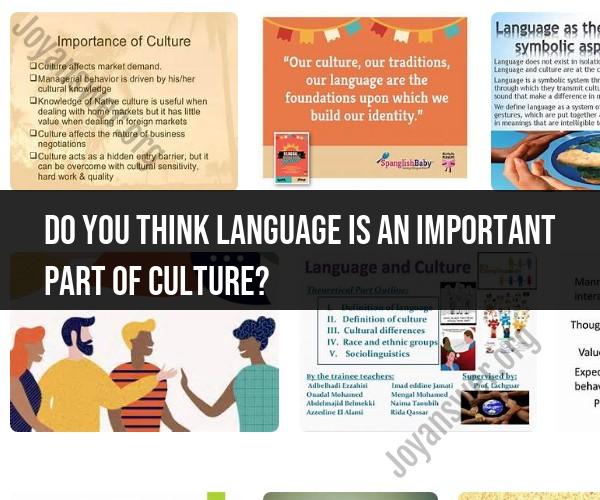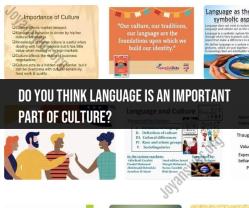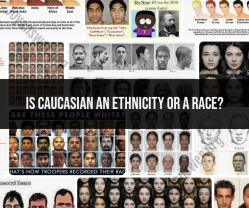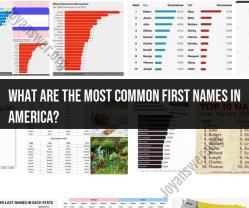Do you think language is an important part of Culture?
Yes, language is undeniably a crucial and integral part of culture. Language and culture are deeply intertwined, and one significantly influences the other. Here are some reasons why language is of paramount importance within the context of culture:
Communication: Language is the primary means of communication within a cultural group. It enables people to convey their thoughts, ideas, and emotions to others. Effective communication is essential for transmitting cultural norms, values, traditions, and knowledge from one generation to the next.
Identity and Belonging: Language often serves as a marker of cultural identity. People who share a common language often feel a strong connection to their cultural roots. Language can be a symbol of belonging, and it helps individuals relate to their heritage and cultural background.
Preservation of Tradition: Language is instrumental in preserving a culture's traditions and historical knowledge. Many cultural practices, rituals, stories, and folklore are passed down through generations via oral or written language. Without language, these valuable cultural elements would be lost.
Shared Values and Norms: Language is a vehicle for conveying a culture's values and norms. Through language, societies can articulate their ethical, moral, and behavioral standards. Proverbs, idioms, and stories often carry the wisdom and guidance of a culture, shaping the way people perceive and navigate the world.
Cultural Expression: Language is a medium for artistic and cultural expression. Literature, poetry, music, theater, and storytelling are all deeply rooted in language. Different languages can offer unique nuances and artistic forms that contribute to a culture's richness and diversity.
Social Cohesion: A shared language facilitates social cohesion. It enables people to form relationships, cooperate, and collaborate within a community. Language creates a sense of trust and solidarity among speakers, which is crucial for a culture's social fabric.
Worldview and Perception: Language influences how people perceive and interpret the world. Different languages have varying ways of expressing ideas and experiences, which can shape a culture's worldview. For example, some languages have specific words for concepts that may not exist in other languages, reflecting different cultural priorities and perspectives.
Adaptation and Change: Language is not static but evolves over time. As cultures adapt to changing circumstances, so does their language. This dynamic relationship between language and culture allows societies to incorporate new ideas, technologies, and influences while preserving their core values.
Diversity and Multilingualism: Many cultures are multilingual, with multiple languages coexisting within a single society. This linguistic diversity can enrich a culture by bringing in a variety of perspectives and influences. Multilingualism can also foster tolerance and understanding between different cultural groups.
In summary, language is an indispensable cornerstone of culture. It not only serves as a tool for communication but also plays a pivotal role in shaping, preserving, and expressing the values, traditions, and identity of a culture. The significance of language in culture is profound, and it is a fundamental aspect of what defines a group of people and their shared heritage.
Language's Vital Role in Culture: A Multifaceted Perspective
Language is a vital part of culture. It is the medium through which we communicate our thoughts, feelings, and values. It is also the way we share our stories, traditions, and beliefs. Language shapes our worldview and helps us to understand ourselves and our place in the world.
Language plays a multifaceted role in culture. It is:
- A cultural beacon and symbol. Language is a powerful symbol of cultural identity. It is one of the things that makes us unique as individuals and as members of a particular culture. Our language shapes the way we think, perceive the world, and express ourselves.
- A vessel for cultural nuances and diversity. Language reflects the unique experiences and perspectives of a culture. It contains nuances and expressions that are difficult or impossible to translate into other languages. This diversity of language enriches the world and helps us to understand different cultures.
- A bridge to identity. Language is a key component of our identity. It is the way we express ourselves and connect with others. It is also the way we learn about our culture and heritage.
Language as a Cultural Beacon and Symbol
Language is a powerful symbol of cultural identity. It is one of the things that makes us unique as individuals and as members of a particular culture. Our language shapes the way we think, perceive the world, and express ourselves.
For example, the Japanese language has a number of words and expressions that emphasize politeness and respect, which are important values in Japanese culture. The Chinese language has a number of words and expressions that reflect the Confucian philosophy of harmony and balance.
Language is also a powerful tool for cultural preservation. It is through language that we pass down our cultural heritage, traditions, and beliefs from generation to generation.
For example, many cultures have traditional stories and songs that are passed down through oral tradition. These stories and songs often reflect the culture's values, beliefs, and way of life.
Cultural Nuances and Diversity Through Language
Language reflects the unique experiences and perspectives of a culture. It contains nuances and expressions that are difficult or impossible to translate into other languages. This diversity of language enriches the world and helps us to understand different cultures.
For example, the Inuit language has over 50 words for snow, reflecting the importance of snow in their culture. The Arabic language has over 100 words for camel, reflecting the importance of camels in their culture.
Language can also be used to express cultural values and beliefs. For example, the Spanish language has a number of words and expressions that reflect the importance of family and community. The Swahili language has a number of words and expressions that reflect the importance of respect and harmony.
Language and Identity: A Profound Connection
Language is a key component of our identity. It is the way we express ourselves and connect with others. It is also the way we learn about our culture and heritage.
Our language shapes the way we think about ourselves and the world around us. It influences our values, beliefs, and attitudes. It also helps us to connect with others who share our language and culture.
For example, people who speak the same language are often more likely to share the same cultural values and beliefs. They are also more likely to feel a sense of connection and community with each other.
The Ongoing Dialogue of Language and Culture
Language and culture are in a constant dialogue with each other. Language is shaped by culture, and culture is shaped by language.
As cultures change, so too does their language. New words and expressions are created to reflect new experiences and ideas. For example, the English language has incorporated many words from other languages, such as Spanish, French, and Chinese, as a result of cultural exchange.
Language also plays a role in shaping culture. For example, the development of new forms of media, such as the internet and social media, has led to new ways of using language and communicating.
The ongoing dialogue between language and culture is what makes the world such a rich and diverse place. It is through language that we are able to learn about and connect with different cultures.










